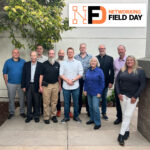|
|
 Graphiant Presented at Networking Field Day 39 |
This Presentation date is November 5, 2025 at 9:00-10:30.
Presenters: Arsalan Mustafa Khan, Vinay Prabhu
Follow on Twitter using the following hashtags or usernames: #NFD39
About Graphiant NaaS with Arsalan Khan
Watch on YouTube
Watch on Vimeo
As enterprises accelerate AI adoption, data governance and network security have become inseparable. In Graphiant’s Networking Field Day presentation titled, “Why Data Governance Demands a Unified and Secure Approach to AI Networking,” Graphiant explores how a secure, compliant, and unified networking infrastructure is essential to enable responsible AI at scale.
Arsalan Khan framed the core problem: enterprises are investing heavily in AI, but their data is siloed across on-prem data centers, multiple clouds, and emerging neocloud providers. This creates massive infrastructure headaches, high costs, and significant security risks. The challenge is compounded by complex data governance regulations, especially for sensitive PII in finance and healthcare. Khan noted that while traditional networking struggles to “catch up” to new technologies, AI demands moving the “whole haystack,” not just finding needles, making network-level control and compliance essential from the start.
Graphiant’s solution is a Network-as-a-Service (NaaS) built on a stateless core, which functions as an overlay/underlay network operated by Graphiant using leased fiber. This provides a single, ubiquitous fabric for any-to-any connectivity with SLA guarantees. The key, Khan emphasized, is simplifying the “plumbing” so businesses can focus on their AI goals. The platform provides centralized visibility and control over metadata, allowing enterprises to see traffic paths and applications (without decrypting payloads) and enforce granular policies, such as guaranteeing that specific data never leaves a geographical boundary. This approach aims to provide the auditability, security, and cost-effectiveness required to manage modern AI data flows.
Personnel: Arsalan Mustafa Khan
Graphiant Use Cases with Arsalan Khan
Watch on YouTube
Watch on Vimeo
Graphiant’s CSO, Arsalan Khan, detailed use cases focused on this challenge, beginning with unified connectivity. He explained that the Graphiant fabric treats all endpoints, public clouds, data centers, and emerging AI neoclouds, as part of a single any-to-any fabric. This model eliminates the need for traffic backhauling, providing lower latency and guaranteed paths for high-bandwidth AI workloads, all while ensuring data privacy with end-to-end encryption that is never decrypted in transit.
Khan then highlighted business-to-business data exchange and data assurance as key enablers for AI. The platform simplifies partner collaboration, which is critical for many AI ecosystems, by handling network complexities like IP overlapping and NAT. This capability extends to partners not on the Graphiant platform and includes the ability to dynamically revoke access if a partner is breached. The core data assurance use case provides a centralized tool for CISO and governance teams. Using role-based access control, they can enforce network-level policies, such as ensuring specific data never leaves a geographical boundary, rather than relying on individual application developers to implement compliance.
Finally, Khan addressed how this infrastructure specifically serves AI workloads. He clarified the strategy is “networking for AI,” meaning the platform is designed to offload the complex burden of security and data governance from AI applications to the network itself. This accelerates AI deployment by simplifying compliance. The system supports this with threat intelligence that, without inspecting encrypted payloads, uses public feeds and behavioral analysis. By classifying normal application flows, the network can detect and flag erratic behavior, providing an essential layer of security for moving and processing the large, sensitive data “haystacks” required by AI.
Personnel: Arsalan Mustafa Khan
Graphiant: The AI Strategy
Watch on YouTube
Watch on Vimeo
Vinay Prabhu, Chief Product Officer at Graphiant, outlined a two-part strategy encompassing network for AI and AI for network. The network for AI pillar addresses the challenge of AI being a massive distributed publisher and subscriber problem, where data is generated in one location and inference happens in another, often across different business boundaries. To manage this, Graphiant provides a platform for secure data exchange, analogous to financial or healthcare workloads. Prabhu emphasized that simplifying exchange is insufficient without trust, using a ride-sharing app analogy: just as a passenger needs to see the driver and the path, enterprises need real-time observability, auditability, and centralized control to program governance policies directly onto the global fabric.
The second pillar, AI for the network, is embodied by GINA (Graphiant Intelligent Network Assistant). GINA is designed to act as a virtual member of the operations team, automating complex, time-consuming tasks. Prabhu gave the example of a CSO requesting a monthly compliance report, a task that might take an hour to manually collate data from various dashboards and databases. GINA can generate this report, along with threat intelligence and infrastructure insights, almost instantly. Prabhu summarized GINA’s value as running a 60-minute stand-up in 60 seconds, buying back valuable time for practitioners to focus on innovation rather than manual data gathering.
Personnel: Vinay Prabhu
Graphiant Demos with Vinay Prabhu
Watch on YouTube
Watch on Vimeo
Chief Product Officer Vinay Prabhu demonstrated the Graphiant infrastructure, first focusing on the network for AI. He framed AI as a massive publisher-subscriber problem and demoed a B2B data exchange where services, like GPU farms, can be published to a personal marketplace. This allows partners (both on and off-network) to be securely connected in minutes, automating complex routing, NAT, and security. This capability is then monitored by the Data Assurance Dashboard, which uses a real-time telemetry pipeline (correlating NetFlow, DNS, and DPI) to provide deep visibility without decrypting payloads. This dashboard identifies malicious threats, provides full auditability, and offers an “Uber-like” spatial and temporal view, allowing operators to prove an application’s exact path and confirm compliance with geofencing policies.
This visibility enables absolute control, where users can define policies for performance, path, or risk. Prabhu confirmed customers can enforce policies to drop traffic rather than failover to a non-compliant path, ensuring governance is never compromised. The presentation concluded with the AI for the network component: GINA, the Graphiant Intelligent Network Assistant. GINA acts as a virtual team member, capable of running a “60-minute stand-up in 60 seconds” by generating guided operational and compliance reports. Prabhu stressed that GINA does not train on customer data; it uses Generative AI to interpret queries and accesses information strictly through the user’s existing role-based access control (RBAC) APIs, ensuring data remains secure.
Personnel: Vinay Prabhu








